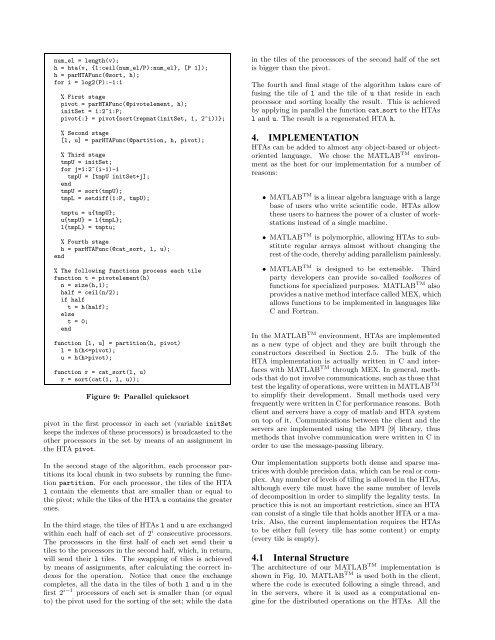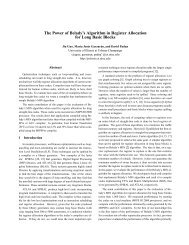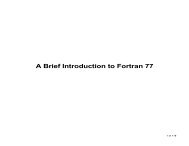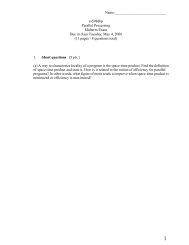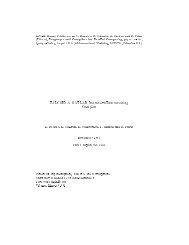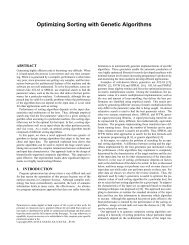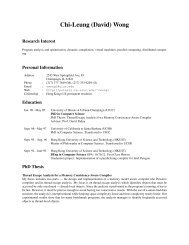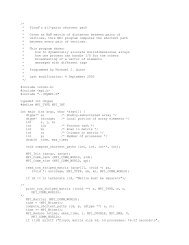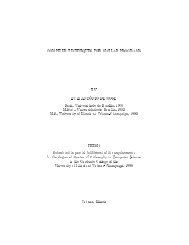The Hierarchically Tiled Arrays Programming Approach
The Hierarchically Tiled Arrays Programming Approach
The Hierarchically Tiled Arrays Programming Approach
Create successful ePaper yourself
Turn your PDF publications into a flip-book with our unique Google optimized e-Paper software.
num_el = length(v);h = hta(v, {1:ceil(num_el/P):num_el}, [P 1]);h = parHTAFunc(@sort, h);for i = log2(P):-1:1% First stagepivot = parHTAFunc(@pivotelement, h);initSet = 1:2^i:P;pivot{:} = pivot{sort(repmat(initSet, 1, 2^i))};% Second stage[l, u] = parHTAFunc(@partition, h, pivot);% Third stagetmpU = initSet;for j=1:2^(i-1)-1tmpU = [tmpU initSet+j];endtmpU = sort(tmpU);tmpL = setdiff(1:P, tmpU);tmptu = u{tmpU};u{tmpU} = l{tmpL};l{tmpL} = tmptu;% Fourth stageh = parHTAFunc(@cat_sort, l, u);end% <strong>The</strong> following functions process each tilefunction t = pivotelement(h)n = size(h,1);half = ceil(n/2);if halft = h(half);elset = 0;endfunction [l, u] = partition(h, pivot)l = h(hpivot);function r = cat_sort(l, u)r = sort(cat(1, l, u));Figure 9: Parallel quicksortpivot in the first processor in each set (variable initSetkeeps the indexes of these processors) is broadcasted to theother processors in the set by means of an assignment inthe HTA pivot.In the second stage of the algorithm, each processor partitionsits local chunk in two subsets by running the functionpartition. For each processor, the tiles of the HTAl contain the elements that are smaller than or equal tothe pivot; while the tiles of the HTA u contains the greaterones.In the third stage, the tiles of HTAs l and u are exchangedwithin each half of each set of 2 i consecutive processors.<strong>The</strong> processors in the first half of each set send their utiles to the processors in the second half, which, in return,will send their l tiles. <strong>The</strong> swapping of tiles is achievedby means of assignments, after calculating the correct indexesfor the operation. Notice that once the exchangecompletes, all the data in the tiles of both l and u in thefirst 2 i−1 processors of each set is smaller than (or equalto) the pivot used for the sorting of the set; while the datain the tiles of the processors of the second half of the setis bigger than the pivot.<strong>The</strong> fourth and final stage of the algorithm takes care offusing the tile of l and the tile of u that reside in eachprocessor and sorting locally the result. This is achievedby applying in parallel the function cat sort to the HTAsl and u. <strong>The</strong> result is a regenerated HTA h.4. IMPLEMENTATIONHTAs can be added to almost any object-based or objectorientedlanguage. We chose the MATLAB TM environmentas the host for our implementation for a number ofreasons:• MATLAB TM is a linear algebra language with a largebase of users who write scientific code. HTAs allowthese users to harness the power of a cluster of workstationsinstead of a single machine.• MATLAB TM is polymorphic, allowing HTAs to substituteregular arrays almost without changing therest of the code, thereby adding parallelism painlessly.• MATLAB TM is designed to be extensible. Thirdparty developers can provide so-called toolboxes offunctions for specialized purposes. MATLAB TM alsoprovides a native method interface called MEX, whichallows functions to be implemented in languages likeC and Fortran.In the MATLAB TM environment, HTAs are implementedas a new type of object and they are built through theconstructors described in Section 2.5. <strong>The</strong> bulk of theHTA implementation is actually written in C and interfaceswith MATLAB TM through MEX. In general, methodsthat do not involve communications, such as those thattest the legality of operations, were written in MATLAB TMto simplify their development. Small methods used veryfrequently were written in C for performance reasons. Bothclient and servers have a copy of matlab and HTA systemon top of it. Communications between the client and theservers are implemented using the MPI [9] library, thusmethods that involve communication were written in C inorder to use the message-passing library.Our implementation supports both dense and sparse matriceswith double precision data, which can be real or complex.Any number of levels of tiling is allowed in the HTAs,although every tile must have the same number of levelsof decomposition in order to simplify the legality tests. Inpractice this is not an important restriction, since an HTAcan consist of a single tile that holds another HTA or a matrix.Also, the current implementation requires the HTAsto be either full (every tile has some content) or empty(every tile is empty).4.1 Internal Structure<strong>The</strong> architecture of our MATLAB TM implementation isshown in Fig. 10. MATLAB TM is used both in the client,where the code is executed following a single thread, andin the servers, where it is used as a computational enginefor the distributed operations on the HTAs. All the


